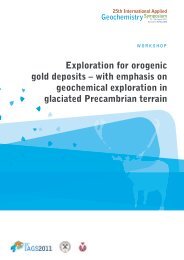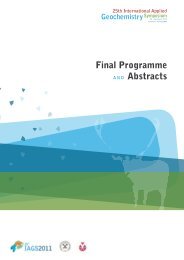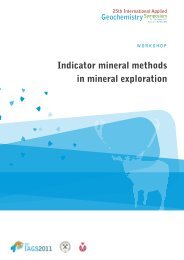IOCG and Porphyry-Cu deposits in Northern Finland ... - IAGS 2011
IOCG and Porphyry-Cu deposits in Northern Finland ... - IAGS 2011
IOCG and Porphyry-Cu deposits in Northern Finland ... - IAGS 2011
You also want an ePaper? Increase the reach of your titles
YUMPU automatically turns print PDFs into web optimized ePapers that Google loves.
affected by higher heat flow at c. 1.8 Ga.<br />
In central F<strong>in</strong>nish Lapl<strong>and</strong>, the follow<strong>in</strong>g<br />
metamorphic zones have been mapped (Hölttä et al.<br />
2007): I) granulite facies migmatitic amphibolites<br />
south of the Lapl<strong>and</strong> Granulite Belt, II) high pressure<br />
mid-amphibolite facies rocks south of the zone<br />
I, characterised by garnet-kyanite-biotite-muscovite<br />
assemblages with local migmatisation <strong>in</strong> metapelites,<br />
<strong>and</strong> garnet-hornblende-plagioclase assemblages <strong>in</strong><br />
mafic rocks, III) low-pressure mid-amphibolite facies<br />
rocks south of the zone II, with garnet-<strong>and</strong>alusite-staurolite-chlorite-muscovite<br />
assemblages with<br />
retrograde chloritoid <strong>and</strong> kyanite <strong>in</strong> metapelites,<br />
<strong>and</strong> hornblende-plagioclase-quartz±garnet <strong>in</strong> metabasites,<br />
IV) greenschist facies rocks of the Central<br />
Lapl<strong>and</strong> Greenstone Belt, with f<strong>in</strong>e-gra<strong>in</strong>ed white<br />
mica-chlorite-biotite-albite-quartz <strong>in</strong> metapelites,<br />
<strong>and</strong> act<strong>in</strong>olite-albite-chlorite-epidote-carbonate <strong>in</strong><br />
metabasites, V) prograde metamorphism south of<br />
the zone IV from lower-amphibolite (<strong>and</strong>alusitekyanite-staurolite-muscovite-chlorite±chloritoid<br />
schists), to mid-amphibolite facies (kyanite-<strong>and</strong>alus-<br />
Iron oxide <strong>and</strong> iron oxide-<strong>Cu</strong>-Au<br />
<strong>deposits</strong> <strong>in</strong> the Kolari-Pajala district<br />
Tero Niiranen<br />
Geological Survey of F<strong>in</strong>l<strong>and</strong>, Rovaniemi, F<strong>in</strong>l<strong>and</strong><br />
Introduction<br />
The Kolari (F<strong>in</strong>l<strong>and</strong>) <strong>and</strong> Pajala (Sweden) areas<br />
have long been known for their iron <strong>deposits</strong>. Earliest<br />
records for the exploration <strong>and</strong> m<strong>in</strong><strong>in</strong>g of the<br />
iron oxide <strong>deposits</strong> <strong>in</strong> the district are from 17th<br />
century (Hiltunen, 1982). Small scale m<strong>in</strong><strong>in</strong>g was<br />
carried out <strong>in</strong> Juvakaisenmaa magnetite occurrence<br />
<strong>in</strong> Kolari around 1840. Modern exploration <strong>in</strong> Pajala<br />
area dur<strong>in</strong>g 1950s to 1960s by SGU <strong>and</strong> LKAB<br />
resulted discovery of around 10 magnetite occurrences<br />
of various size, however, at the time all of<br />
those were considered uneconomic. Exploration <strong>in</strong><br />
the Kolari area by Rautaruukki Oyj dur<strong>in</strong>g 1950s<br />
to 1980s resulted discovery of about 15 magnetite<br />
<strong>and</strong> magnetite-<strong>Cu</strong>-Au <strong>deposits</strong>. Two <strong>deposits</strong> at<br />
the Kolari area were exploited dur<strong>in</strong>g 1974-1992<br />
by Rautaruukki Oyj produc<strong>in</strong>g iron, copper, <strong>and</strong><br />
gold. In 2005 Northl<strong>and</strong> Resources SA staked the<br />
known occurrences <strong>in</strong> both Kolari <strong>and</strong> Pajala area<br />
the company has s<strong>in</strong>ce been develop<strong>in</strong>g the targets<br />
aim<strong>in</strong>g to start m<strong>in</strong><strong>in</strong>g <strong>in</strong> late 2012 (Northl<strong>and</strong> data).<br />
ite-staurolite-biotite-muscovite gneisses, <strong>and</strong> upper<br />
amphibolite facies garnet-sillimanite-biotite gneisses,<br />
VI) amphibolite facies pluton-derived metamorphism<br />
related with heat flow from central <strong>and</strong> western<br />
Lapl<strong>and</strong> granitoids.<br />
The present structural geometry shows an<br />
<strong>in</strong>verted gradient where pressure <strong>and</strong> temperature<br />
<strong>in</strong>crease up wards <strong>in</strong> the present tectonostratigraphy<br />
from greenschist facies <strong>in</strong> the zone IV through<br />
garnet-<strong>and</strong>alusite-staurolite grade <strong>in</strong> the zone III<br />
<strong>and</strong> garnet-kyanite grade amphibolite facies <strong>in</strong> the<br />
zone II to granulite facies <strong>in</strong> the zone I. The <strong>in</strong>verted<br />
gradient could be expla<strong>in</strong>ed by crustal thicken<strong>in</strong>g<br />
caused by overthrust of the hot granulite complex<br />
onto the lower grade rocks. Metamorphism <strong>in</strong> the<br />
Lapl<strong>and</strong> Granulite Belt occurred at 1.91–1.88 Ga<br />
(Tuisku & Huhma 2006), but the present metamorphic<br />
structure <strong>in</strong> central F<strong>in</strong>nish Lapl<strong>and</strong> may record<br />
later, postmetamorphic thrust<strong>in</strong>g <strong>and</strong> fold<strong>in</strong>g events<br />
(Hölttä et al. 2007).<br />
General Geology of the Kolari-Pajala area<br />
The bedrock of the Kolari-Pajala district is comprized<br />
by 2.44-1.91 Ga Karelian <strong>and</strong>






